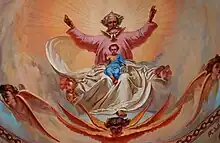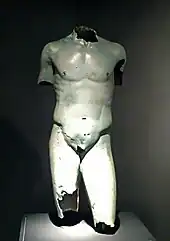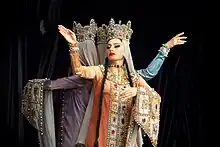Culture of Georgia (country)
The culture of Georgia has evolved over the country's long history, providing it with a unique national identity and a strong literary tradition based on the Georgian language and alphabet. This strong sense of national identity has helped to preserve Georgian distinctiveness despite repeated periods of foreign occupation.
| Part of a series on the |
| Culture of Georgia (country) |
|---|
 |
| History |
| People |
| Languages |
| Mythology |
| Cuisine |
| Festivals |
| Religion |
| Art |
| Literature |
| Music |
| Sport |
Culture of Ancient and Old Georgia
.jpg.webp)
The Georgian alphabet is traditionally said to have been invented in the 3rd century BC and reformed by King Parnavaz I of Iberia in 284 BC. Most modern scholarship puts its origin date at some time in the 5th century AD, when the earliest examples can be found.
Georgia's medieval culture was greatly influenced by Eastern Orthodox Christianity and the Georgian Orthodox and Apostolic Church, which promoted and often sponsored the creation of many works of religious devotion. These included churches and monasteries, works of art such as icons, and hagiographies of Georgian saints. In addition, many secular works of national history, mythology, and hagiography were also written.
Ecclesiastical art

Medieval Georgian icons are renowned as being among the finest creations of Orthodox religious art. Notable examples include:
- The Icon of 886 from Zarzma monastery
- The Icon of the 9th century from Tsilkani
- The famous Wonderworking Iberian Icon of the Mother of God (10th century)
- The Icon of the 10th century from Okona
- The Icon of Our Lady of Khakhuli of the 12th century
- The Icon of St. George of the 11th century from Labechina
- The Icon of St. George of the 11th century from Nakipari
- The Icon of the 12th century from Anchiskhati
- The Icon of the 14th century from Ubisa
- The Icon of the 16th century from Alaverdi
Ecclesiastical monuments


Well-known monuments of Georgian Christian architecture include:
- The Georgian Church in Bethlehem (4th century)
- The Church of Gavazi (4th century) in Akhalsopeli (Kvareli district of Kakheti region)
- Akaurta Church (5th century) in Bolnisi district (Kvemo Kartli region)
- Ikalto Monastery complex (5th-7th centuries) (Kakheti)
- Sioni Church (5th century) in Bolnisi
- Monastery of Shio Mghvime (6th century)
- Davidgareja Monastery complex (6th-7th centuries)
- Jvari Monastery in Mtskheta (6th century)
- Anchiskhati Church (6th century) in Tbilisi
- Nekresi Monastery Complex (4th-9th centuries) in Kakheti
- Sioni church (7th century) in Ateni
- Petritsoni Monastery in Bulgaria (11th century)
- The Georgian Monastery (10th century) on the Black Mountain in Syria (now territory of Turkey)
- The Georgian Iveron Monastery on Athos (10th century)
- Svetitskhoveli Cathedral in Mtskheta (11th century)
- Opiza Monastery (10th century) in Tao-Klarjeti (now territory of Turkey)
- Monastery Doliskana (10th century) in Tao-Klarjeti (now territory of Turkey)
- Monastery Otkhta-Eklesia in Tao-Klarjeti (now territory of Turkey)
- Oshki Monastery (10th century) in Tao-Klarjeti (now territory of Turkey)
- Bagrati Cathedral (11th century) in Kutaisi
- Gelati Monastery (11th century) in Kutaisi
- Motsameta monastery (11th century) in Imereti
- Sioni Cathedral (11th century) in Tbilisi
- Alaverdi church (11th century) in Kakheti
- Monastery Samtavro (12th century) in Mtskheta
- Vardzia Monastery (12th century) in Meskheti
- Gialia Monastery (10th-16th centuries) in Cyprus
Well-known Georgian painters were Damiane (13th century), Anania (15th century), Mamuka Tavakarashvili (17th century), etc.
The works of the famous Georgian goldsmiths, Beka and Beshken Opizari (11th century), are outstanding contributions to world art.
Literary and other written works
Important Georgian literary works of the pre-Christian period are:
- Amiraniani, ancient Georgian folk epos (see also: Amiran-Darejaniani and Amirani).
Notable Georgian written works from the medieval period include:
- Martyrdom of the Holy Queen Shushanik by Iakob Tsurtaveli (the oldest surviving work of the Georgian literature written between 476 and 483)
- Corpus Areopagiticum, a philosophical and theological work attributed by some to Peter the Iberian (5th century)
- The Life of Saint Nino (8th century) (anon)[1]
- The Martyrdom of Abo Tbileli by Ioane Sabanisdze (8th century)
- The Life of Grigol Khandzteli by Giorgi Merchule (10th century)
- A History of the Georgian Kings ("Tskhovreba Kartvelta Mepeta") by Leonti Mroveli (11th century)
- A History of the Royal House of Bagrationi by Sumbat Davitisdze (11th century)
- Eteriani, a folk epic (c. 11th century)
- Life of the King Farnavaz (anon) (11th century)
- Ustsoro Karabadini (Peerless Karabadini) (11th century)[2]
- Tamariani by Ioane Chakhrukhadze (12th century)
- Shen Khar Venakhi ("Thou Art a Vineyard"), the famous Georgian hymn by the King Demetre I Bagrationi (12th century)
- Vepkhistkaosani (The Knight in the Panther's Skin), a national epic poem by Shota Rustaveli (12th century)
- Abdulmesiani by Ioane Shavteli (13th century)
- Kartlis Tskhovreba (History of Georgia), a collection of old Georgian chronicles (from ancient times to the 14th century)
Culture of Georgia today

Starting from the early 16th century,[3] although certain aspects of more recent times were already incorporated since the 12th century,[4] until the course of the 19th century, Georgian culture became significantly influenced by Persian culture.[5] Though notably more visibly amongst the higher classes, Persian cultural aspects were incorporated amongst the already existing Georgian columns, especially painting, architecture, and literature.[3] The French traveller Jean Chardin who visited Georgia in 1672 noted that the Georgians of the kingdom of Kartli followed Persian customs.[3][6] Since many Georgian kings, princes, and nobles were either born or raised in mainland Iran, it is not surprising that Persian cultural aspects spread in Georgia.[3]
During the modern period, from about the 17th century onwards, Georgian culture has been greatly influenced by cultural innovations imported from elsewhere in Europe.
The first Georgian-language printing house was established in the 1620s in Italy, and the first one in Georgia itself was founded in 1709 in Tbilisi.
Georgian theatre has a long history; its oldest national form was the "Sakhioba" (extant from the 3rd century BC to the 17th century AD). The Georgian National Theatre was founded in 1791 in Tbilisi, by the writer, dramatist, and diplomat Giorgi Avalishvili (1769–1850). Its leading actors were Dimitri Aleksi-Meskhishvili, David Machabeli, David Bagrationi, Dimitri Cholokashvili, and others.

In Tbilisi, the Museum of the Caucasus was founded in 1845. In the 1920s, it became the State Museum of Georgia. The Tbilisi State Theatre of Opera and Ballet was established in 1851.
Greatest representatives of Georgian culture of the 19th century were: Nikoloz Baratashvili (poet), Alexander Orbeliani (writer), Vakhtang Orbeliani (poet), Dimitri Kipiani (writer), Grigol Orbeliani (poet), Ilia Chavchavadze (writer and poet), Akaki Tsereteli (poet), Alexander Kazbegi (writer), Rapiel Eristavi (poet), Mamia Gurieli (poet), Iakob Gogebashvili (writer), Simon Gugunava (poet), Babo Avalishvili-Kherkheulidze (actor), Nikoloz Avalishvili (actor), Nikoloz Aleksi-Meskhishvili (actor), Romanoz Gvelesiani (painter), Grigol Maisuradze (painter), Alexandre Beridze (painter), Ivane Machabeli (translator), Okropir Bagrationi (translator), Sardion Aleksi-Meskhishvili (translator), Kharlampi Savaneli (opera singer), Pilimon Koridze (opera singer), Lado Agniashvili (folk singer), Alois Mizandary (composer), etc.
The first cinema in Georgia was established in Tbilisi on November 16, 1896. The first Georgian cinema documentary ("Journey of Akaki Tsereteli in Racha-Lechkhumi") was shot in 1912 by Vasil Amashukeli (1886–1977), while the first Georgian feature film ("Kristine") was shot in 1916 by Alexandre Tsutsunava (1881–1955).
The Tbilisi State Academy of Arts was founded in 1917.
Georgian culture suffered under the rule of the Soviet Union during the 20th century, during which a policy of Russification was imposed but was strongly resisted by many Georgians. Since the independence of Georgia in 1991, a cultural resurgence has taken place, albeit somewhat hampered by the country's economic and political difficulties in the post-Soviet era.
Cuisine
Georgian cuisine refers to the cooking styles and dishes created by the Georgians. The Georgian cuisine is unique to the country, but also carries some influences from other Caucasian, Eastern European and nearby Middle Eastern culinary traditions. Each historical province of Georgia has its own distinct culinary tradition, with variations such as Abkhazian, Megrelian, Kakhetian, Imeretian, Svanetian, Pshavian, Tushian, Kartlian, Gurian, Meskhian, Rachian and Adjarian cuisines. Rich with meat dishes, the Georgian cuisine also offers a variety of vegetarian dishes.
Georgian cuisine is the result of the broad interplay of culinary ideas carried along the Silk Road Trade route by merchants and travelers alike.[7] The importance of both food and drink to Georgian culture is best observed during a feast called supra, when a huge assortment of dishes are prepared, always accompanied by large amounts of local wine, known to be one of the world's oldest wines, produced in ancient authentic Georgian underground kvevri clay pots (dating 8 century BC). In a Georgian feast, the role of the tamada (toastmaster) is an important and honoured position.
Famous Georgian cultural figures
Some famous Georgian cultural figures from the 20th–21st centuries are:
Actors
- David "Dodo" Abashidze
- Veriko Anjaparidze
- Spartak Bagashvili
- Givi Berikashvili
- Ramaz Chkhikvadze
- Kakhi Kavsadze
- Ipolite Khvichia
- Akaki Khorava
- Zurab Kipshidze
- Avtandil Makharadze
- Merab Ninidze
- Guram Sagaradze
- Karlo Sakandelidze
- Sesilia Takaishvili
- Bukhuti Zakariadze
- Sergo Zakariadze
- Nato Vachnadze
- Sofiko Chiaureli
Composers
Filmmakers
Opera singers
Painters

Pianists
Poets

- Shota Rustaveli
- Galaktion Tabidze
- Alexander Abasheli
- Irakli Abashidze
- Rati Amaglobeli
- Diana Anphimiadi
- Lado Asatiani
- Valerian Gaprindashvili
- Terenti Graneli
- Ioseb Grishashvili
- Paolo Iashvili
- Ana Kalandadze
- Giorgi Leonidze
- Mukhran Machavariani
- David Magradze
- Kolau Nadiradze
- Vazha-Pshavela
- Titsian Tabidze
- Nikoloz Baratashvili
- Ilia Chavchavadze
- Akaki Tsereteli
- Bela Chekurishvili
Theatre producers
Writers, male
- Vasil Barnovi
- Lasha Bugadze
- Otar Chiladze
- Tamaz Chiladze
- Konstantine Gamsakhurdia
- Levan Gotua
- Shalva Dadiani
- Guram Dochanashvili
- Mikheil Javakhishvili
- Otia Ioseliani
- Jemal Karchkhadze
- Leo Kiacheli
- David Kldiashvili
- Aka Morchiladze
- George Papashvily
- Guram Rcheulishvili
- Grigol Robakidze
- Avksenty Tsagareli
- David Turashvili
- Nodar Dumbadze
- Terenti Graneli
- Boygar Razikashvili
Cultural groups
Dance troupes
Choirs
Sport
- Zaza Pachulia (basketball player for Golden State Warriors)
- Kakha Kaladze (footballer for AC Milan)
- Khvicha Kvaratskhelia (footballer for SSC Napoli)
Rugby union is a popular team sport played in Georgia. Rugby union is considered the second most popular sport in Georgia, after football.
See also
References
- Baramidze, Georgian literature
- Destin de la Géorgie, Issues 36-37, 1978, p. 277
- Willem Floor, Edmund Herzig. Iran and the World in the Safavid Age I.B.Tauris, 15 sep. 2012 ISBN 1850439303 p 494
- Betz, Hans Dieter (2008). Religion past and present. Brill (originally from the University of Michigan. p. 361.
(...) Since the 12th century and under Persian cultural influence, secular literature also developed (in Georgia)
- Kennan, Hans Dieter; et al. (2013). Vagabond Life: The Caucasus Journals of George Kennan. University of Washington Press. p. 32.
(...) Iranian power and cultural influence dominated eastern Georgia until the coming of the Russians
- Chardin, Jean (1686). The travels of Sir John Chardin into Persia and the East Indies.
- Food Cultures of the World Encyclopedia, Volume 1, Ken Albala, p. 125
- Chkheidze, Levan. "Georgian Art Portal | Artists". Art.Gov.Ge (in English and Georgian). Didistudia llc. Retrieved 11 October 2020.
Further reading
- Čikovani, Michail Jasonovič; Γlonṭi, Alexandr. "Georgier" [Georgian Narrative Tradition]. In: Enzyklopädie des Märchens Online, edited by Rolf Wilhelm Brednich, Heidrun Alzheimer, Hermann Bausinger, Wolfgang Brückner, Daniel Drascek, Helge Gerndt, Ines Köhler-Zülch, Klaus Roth and Hans-Jörg Uther. Berlin, Boston: De Gruyter, 2016 [1987]. https://www-degruyter-com.wikipedialibrary.idm.oclc.org/database/EMO/entry/emo.5.156/html. Accessed 2023-07-02.
- Kʻurdovaniże, Tʻeimuraz et al. The index of Georgian folktale plot types: systematic directory, according to the system of Aarne-Thompson. Tbilisi: Merani, 2000.
External links
- Georgia History and Culture (in German)
- Georgian Web by Besiki Sisauri
- Friends of Georgia International Foundation Information on Georgian Culture & History
- Georgian eBooks Many online Georgian e-books (PDF) on the CD "Anthology of Georgian classical literature" by UNESCO Project
- Authors
- Georgian Art, Tiflis Avenue
- TITUS projects Armazi and Ecling
- Georgia - South Caucasus (in German and English)
- From the Cradle of Wine
- Kharbedia, Malkhaz: "Conformism and Resistance: The Birth of the Modern Georgian Literature" in the Caucasus Analytical Digest No. 14
- Georgian Contemporary Art Portal (in English and Georgian)
- Web Platform of Comparative Folk Narrative Research, with record of Georgian folktales classified according to the ATU index


